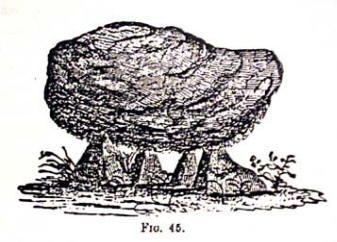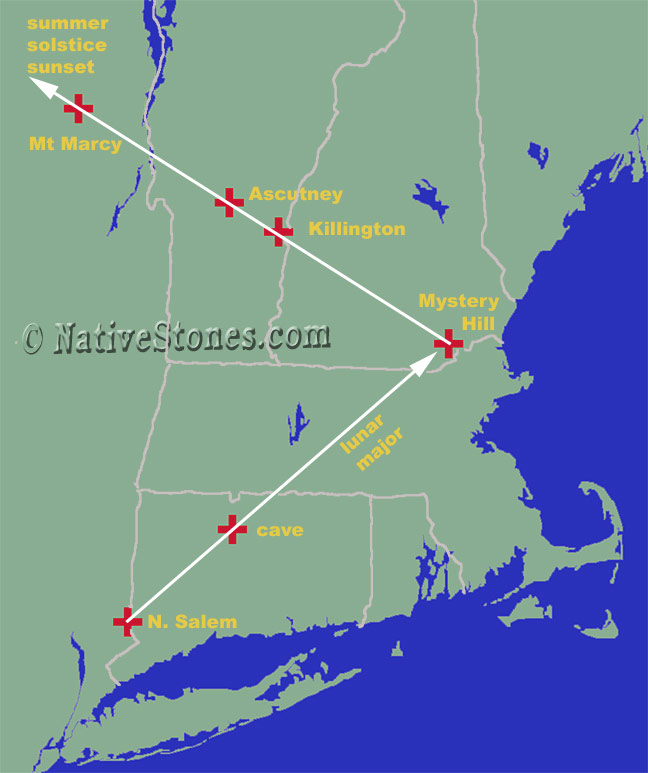|
Propped Boulders
What is a
propped boulder? Propped boulders are supported
with one, two or more stones placed under them to mark them as
having been positioned by man. If more than two were used,
the boulder is usually lifted above the surface, with a gap
separating it from the ground or bedrock.
If elevated above the surface, they are often referred to as
dolmens. While it is probable some of
the propped boulders are natural creations as a result of
glacial action, most were
done by man. Close inspection should be given to the
propping stone(s). If they do not show evidence of
having been glacially tumbled with resulting rounded edges,
consideration must be given to the possibility that it was
positioned. If the propping stones are rounded, this by no
means rules out the possibility of this being an artificial
construction.
What is a dolmen? Strictly speaking, a
dolmen is a European megalithic tomb, constructed with a flat,
table-like capstone resting on uprights and then buried within a
cairn of smaller stones or covered with earth. The term
dolmen has
been applied to propped boulders found in N. America (especially
those examples which are fully elevated), but this is not strictly
correct. The word means 'table' in Gaelic, from
the flat slab placed across supporting pillars of a structure
which apparently was mainly used as a sepulture for a person of
high rank and then buried under a cairn of stones. The
stones of the cairn have usually since been removed for local recycling,
or the earthen cap has eroded away, leaving the interior
construction in plain view. In North America the supported
stone is normally a rounded boulder, in Europe, it is a flat
slab. Probably the most well-known example of a
propped is the
almost 100-ton elevated boulder in the center of North Salem, NY
in northern Westchester County. The boulder is a
pink-tinged gneiss or granite, and rests on supporting marble
standing stones of a white color. A roadside
sign adjacent to the boulder long maintained the stone was a
glacial erratic. In recent years, the possibility of it
being a Viking construction has also been added to this sign,
despite the fact that Vikings never did this sort of thing or of
any evidence they settled as far south as New York. The
possibility of the stone being a Native American creation has
largely escaped consideration.
|

|
|
". . . a
very remarkable rock, supported by five others, as
shown in the following wood-cut, Fig. 45. From
its entire correspondence with the Celtic
cromlech,
this has attracted some considerable attention."
-E.G. Squier, Aboriginal Monuments of the
State of New York; Smithsonian Contributions
to Knowledge, Vol. 2, 1849. |
The supporting marble standing stones are embedded in what appears to be an
artificial terrace. These supports did not decide on their
own to plant themselves in the ground.
The boulder is an effigy of a cat or some other carnivore.
The use of a pink boulder and white supports was done to
underscore the lunar focus of this creation. White and
pink/orange are both associated with the moon, the former is its
color when well-elevated above the horizon, the latter when it
is near the horizon. The moon's
extreme rising/setting points along the horizon occur in an
18.6-year cycle. At the extremes of this cycle, known as
the major lunar standstill, the moon
will rise and set well outside the band the sun traces along the
horizon during its annual migration. (At the latitude of
the North Salem boulder, this translates into about 7°
outside the solstice points of the sun.) From the boulder,
the moon's northernmost rising, when run out across the
landscape, intersects both King Phillip's Cave [an artificial
cave burrowed into the western side of
Talcott Mountain
in Bloomfield, Connecticut] and
Mystery Hill, the
massive stonework complex in New Hampshire.

Mystery Hill is itself carefully positioned in the landscape.
It lies along a unique alignment of three significant mountain
peaks. From Mystery Hill, heading toward the summer
solstice sunset, a straight line intersects the peaks of
Mt. Killington, Mt. Ascutney and finally Mt. Marcy. Mt.
Marcy is the highest peak in New York state, and at 5,344 feet is
the highest
elevation in the Northeast outside the Presidential Range
in New Hampshire. Over the course of many
generations, the Native inhabitants of North America obtained a
complete understanding of the landscape. Such a unique
solstice alignment between mountain peaks would have neither
gone unnoticed nor unmemorialized. Propped boulders fall into one of two
categories: distinct, separate stones outside the bounds of a
surrounding stone complex, and those which reside within a
complex which typically includes some or all of the components
typical of such sites, including walls, cairns, wells, chambers,
etc. The North Salem boulder is an
example of the former, erected as a Native benchmark to trace
out a massive sacred pattern across the landscape. Too
long a subject to explore here, the Natives of the East laid out
long distance sacred alignments between various features of the
landscape and the sky. The Anasazi did the same,
establishing what is today a well-studied
network of sacred roads,
some running hundreds of miles across the Southwestern
landscape. The size of the boulder which was propped
correlates with the length and significance of the alignment it
served to memorialize. The longer and more important an
alignment, the larger the boulder. While most common in the Northeast,
propped boulders (which serve as benchmarks along these sacred
spirit paths) are apparently found across the breadth of the
continent, including areas which were never glaciated. Some can exceed 100 tons in weight. How
were they constructed? As
experiments
prove, one person can easily manipulate over 10 tons alone.
100 tons is well within the realm of what other ancient
civilizations throughout the world are known to have moved and
lifted. In the northern part of this continent, the use of
ramps made of packed snow and ice would have made this task
much easier. Massachusetts-
Little Agassiz Rock, the propped boulder that spawned the
modern theory of glaciers. New Jersey-
Tripod Rock, one
of the more spectacular propped boulders of the Northeast.
Massachusetts- The
Lynn dolmen, now sadly braced with concrete
stabilizers:
New Jersey- This
pedestaled boulder
apparently rests on quarried stones, although the resolution of
the photos makes this difficult to discern.
Worldwide-
Dolmens of the World
an outstanding graphical synopsis of the worldwide dolmen
erecting tradition. This is an extraordinary web site
>>>> more >>>> Fun link: the fine art of
stone balancing.
More
HERE. |


